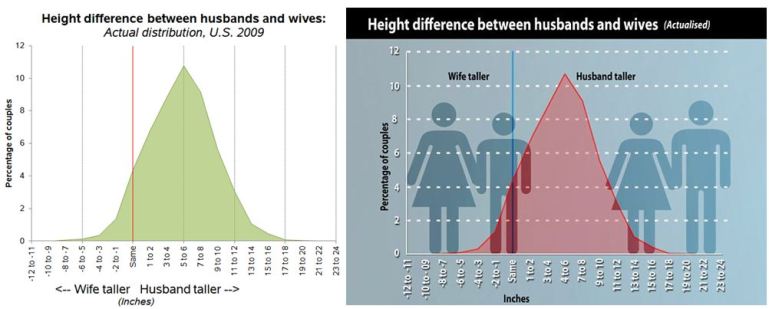My post the other day on height differences between married men and women, which appeared here and on The Atlantic site, drew record clicks to the blog. They mostly originated from this Jezel post by Tracy Moore, which reports about 100,000 readers and more than 1,000 comments on their post.
The UK’s Daily Mail Online also picked up the story, which is understandable since the original research came from a British sample. But I was most impressed by their re-purposing of the figures I made — until I realized they botched it. I don’t know how they made these, since I didn’t include the numbers behind the charts. Here is my figure (on the left), with their adaptation.
I like the bathroom icons showing which spouse is taller. Anyway, that’s the actual distribution, and it seems right. They did the same thing with the randomized height distribution:
 And that seems OK, too. But then for superimposing them, they shrunk the actual distribution down to the scale of the randomized one — I guess not realizing that the y-axis went higher on the actual distribution. As a result, the point was totally lost:
And that seems OK, too. But then for superimposing them, they shrunk the actual distribution down to the scale of the randomized one — I guess not realizing that the y-axis went higher on the actual distribution. As a result, the point was totally lost:
 It’s a lot of trouble to go through in order to get it wrong in the end. I wonder why they didn’t just rip off the original figures, like they did with the text, re-writing most of the post like this:
It’s a lot of trouble to go through in order to get it wrong in the end. I wonder why they didn’t just rip off the original figures, like they did with the text, re-writing most of the post like this:
I said: I made 10 copies of all the men and women in the data, scrambled them up, and paired them at random. Most couples are still husband taller, but now 7.8 percent have a taller wife – more than twice as many.
They said: To do this he made 10 copies of all the men and women in the data, scrambled them up, and paired them at random. Most couples still had a taller husband, but 7.8 per cent had a taller wife – nearly twice as many…
And so on through most of the post. (I also don’t know why they changed my “more than twice as many” to “nearly twice as many,” since I was comparing 3.8 with 7.8. I have checked this a couple of times now and I’m pretty sure 3.8 * 2 = 7.6.)
It’s an interesting (unimportant) case of the blogosphere’s frequently-encountered overlap between free publicity (they publicized the post), plagiarism (they claimed words written by others as their own) and copyright infringement (they republished someone else’s work without permission).


I’ve always worked under the assumption that blog posts unless explicitly copyrighted (which I don’t see here; WordPress has a variety of plugins available to easily add it to blogs they host) then the content works under a “share alike” type license. That to say, yes I would see plagiarism and misrepresentation issues in that post, but copyright, perhaps not. Am I working on a bad assumption?
LikeLike
I believe that assumption is not correct. It is my understanding that copyright attaches whether or not it is explicitly stated in the work. You wrote it, you own it. As far as I can tell from the WordPress terms of service, There is no special treatment of intellectual property as a function of it appearing on this site. Most re-blogging is harmless in that there are no monetary damages, so this does not arise. But I think if somebody took a blog post and sold it for profit I would be on pretty secure footing in attempting to recover that profit (and I am not saying I have any interest in doing that here). Anybody please correct me if you think I’m wrong. (In this case I actually gave permission to the Atlantic to publish the post, But I think I still own it and I can have it back if I want.)
LikeLike
I can have it back if I want.
How can you take back something that’s immaterial?
LikeLike
immaterial
Clarification: since “immaterial” can mean “not important”, let me change that to “non-tangible”.
LikeLike
They have to take my posts down if I want them to. But I can keep them up on here. So that would be like taking it back.
LikeLike
So that would be like taking it back.
I guess I’m too literal-minded…
LikeLike
The Daily Mail are famous here in the UK for four things;
1. Misunderstanding science and statistics.
2. Churnalism (that is, re-hashing of press releases disguised as journalism).
3. Thinking everything in the universe either cures or causes cancer.
4. Racism.
LikeLike